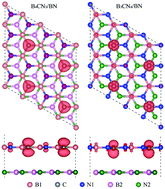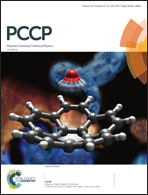Metal-free spin and spin-gapless semiconducting heterobilayers: monolayer boron carbonitrides on hexagonal boron nitride†
Abstract
The interfaces between monolayer boron carbonitrides and hexagonal boron nitride (h-BN) play an important role in their practical applications. Herein, we respectively investigate the structural and electronic properties of two metal-free heterobilayers constructed by vertically stacking two-dimensional (2D) spintronic materials (B4CN3 and B3CN4) on a h-BN monolayer from the viewpoints of lattice match and lattice mismatch models using density functional calculations. It is found that both B4CN3 and B3CN4 monolayers can be stably adsorbed on the h-BN monolayer due to the van der Waals interactions. Intriguingly, we demonstrate that the bipolar magnetic semiconductor (BMS) behavior of the B4CN3 layer and the spin gapless semiconductor (SGS) property of the B3CN4 layer can be well preserved in the B4CN3/BN and B3CN4/BN heterobilayers, respectively. The magnetic moments and spintronic properties of the two systems originate mainly from the 2pz electrons of the carbon atoms in the B4CN3 and B3CN4 layers. Furthermore, the BMS behavior of the B4CN3/BN bilayer is very robust while the electronic property of the B3CN4/BN bilayer is sensitive to interlayer couplings. These theoretical results are helpful both in understanding the interlayer coupling between B4CN3 or B3CN4 and h-BN monolayers and in providing a possibility of fabricating 2D composite B4CN3/BN and B3CN4/BN metal-free spintronic materials theoretically.



 Please wait while we load your content...
Please wait while we load your content...